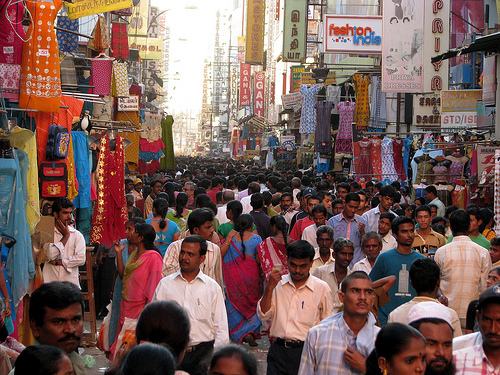 A market street in Chennai, India.Photo: mckaysavage via FlickrJulia Whitty has written a smart, nuanced cover story on population for Mother Jones. She addresses the important issues, she connects the dots, she knows her stuff. But I have a bone to pick.
A market street in Chennai, India.Photo: mckaysavage via FlickrJulia Whitty has written a smart, nuanced cover story on population for Mother Jones. She addresses the important issues, she connects the dots, she knows her stuff. But I have a bone to pick.
About half of the article explores the wide-ranging set of issues associated with global population growth and (over)consumption; the other half focuses on particular problems and signs of progress in India. And the whole thing is illustrated with more than a dozen richly colored photographs of poor or middle-class Indians.
Whitty makes clear that population growth in the developing world is not the main problem, that the high-consuming lifestyles of the rich are the big driver of environmental degradation:
[E]ven though India has a much larger population and a higher rate of population growth than the U.S., its overall carbon legacy is vastly reduced, due to its population’s drastically lower levels of consumption combined with shorter lifespans … At current rates, an American child has 55 times the carbon legacy of a child born to a family in India.
And I can see why Whitty would want to report on India: She has family roots in Kolkata, and she weaves her grandmother’s story into her larger narrative.
But I think both she and Mother Jones erred in making India the focus of this particular piece. A person casually browsing through the magazine is likely to come away with one impression: population problem = India. Even people who read every word of Whitty’s article will be left thinking about the relationship between population pressures and India.
Optics matter. If Indians aren’t the main offenders, why put them in the spotlight? Why not illustrate an article about the global population problem with photos of New York City’s traffic-choked streets, or London’s jam-packed Tube system, or a crowded mega-mall in Alberta, or Phoenix’s bleak sprawl?
Whitty’s words tell a true story; the framing of her article hints at a false one.
Longtime population scholar and activist Paul Ehrlich did the same thing when he began writing about these issues. Ehrlich, who has long been concerned about population increase among all peoples, wrote in the first chapter of his monumental 1968 bestseller The Population Bomb that he first became viscerally aware of the population problem during a late-night taxi ride through Delhi:
The streets seemed alive with people. People eating, people washing, people sleeping, people visiting, arguing and screaming. People thrusting their hands through the taxi window begging. People defecating and urinating. People clinging to buses. People herding animals. People, people, people, people. As we moved through the mob, hand horn squealing, the dust, noise, heat and cooking fires gave the scene a hellish aspect. Would we ever get to our hotel? All three of us [Ehrlich plus his wife and daughter] were, frankly, frightened. … Since that night I’ve known the feel of overpopulation.
As demographer Jack Caldwell wrote later, Ehrlich “did not see population explosion, for Delhi’s birth rate is relatively slow. He probably saw fewer people than one would see with pleasure in New York, London or Paris at Christmas or in the peak hour. What he did see were poor non-Europeans.” (Quoted from The Coming Population Crash by Fred Pearce.)
More than 40 years later, Whitty begins her article with a strikingly similar (though less melodramatically rendered) scene — a late-night taxi ride through crowded streets, this time in Kolkata instead of Delhi.
Even those of us with the best intentions occasionally succumb to inappropriate frames for the population problem. But it’s midleading to use developing nations like India as poster children for overpopulation when it’s resource-hogging, wealthy Westerners like you and me who are causing the most ecological havoc.
In the case of Whitty’s article, the final offense likely wasn’t even her own but an editor’s. The article concludes with a half-page photo of a crowd of Indians alongside a row of raggedy shacks. The caption: “Kolkata’s teeming Malik Ghat wholesale flower market.”
As Gita Mehta dryly observed of her fellow Indians in her classic book Karma Cola, “No one teems like we do.”
—–
Read more about population and the option of going childfree:
- The GINK manifesto: Say it loud: I’m childfree and I’m proud
- Childfree messages in Sex and the City 2 and Eat, Pray, Love
- Pundits criticize Elena Kagan for being childfree
- How green are the ‘childless by choice’?
- Women’s rights are the right way to approach the population issue
- Nearly a fifth of American women skip childbearing
- Want to join the Voluntary Human Extinction Movement?
- And still more about population



